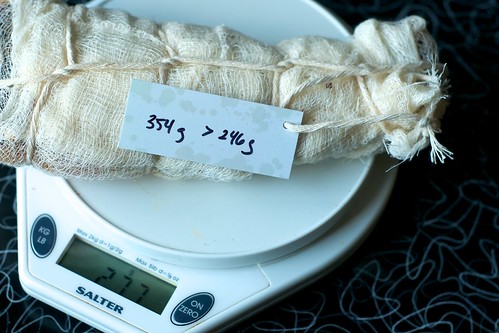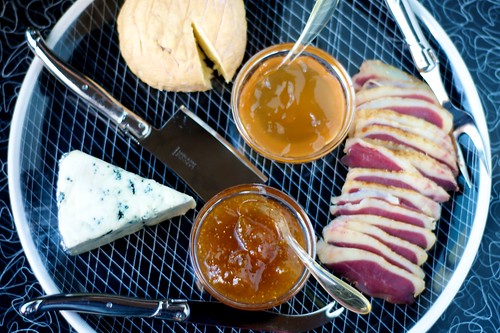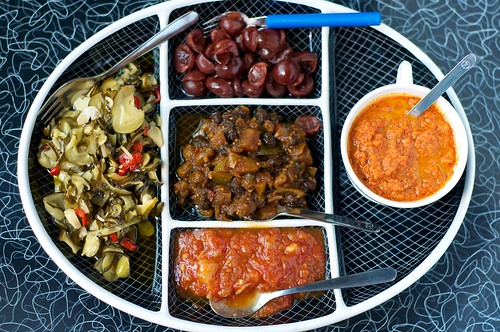Duck prosciutto: Charcutepalooza month one
After last year's relatively easily-gotten success making guanciale, I've been fairly obsessed with the idea of dabbling deeper into charcuterie. I mean, if it's as easy as salting, hanging and waiting, what's not to love? And so, as the winter cool descended upon us, I began to fantasize about setting up a more serious curing chamber in our basement, looking at different options, developing madcap ideas about how to hack something together that would serve the purpose.
 And then, Cathy Barrow from Mrs. Wheelbarrow's Kitchen and Kim Foster of The Yummy Mummy hatched a genius plan: Charcutepalooza! A charcuterie project for each month during the year 2011, all inspired by Michael Ruhlman and Brian Polcyn's book "Charcuterie
And then, Cathy Barrow from Mrs. Wheelbarrow's Kitchen and Kim Foster of The Yummy Mummy hatched a genius plan: Charcutepalooza! A charcuterie project for each month during the year 2011, all inspired by Michael Ruhlman and Brian Polcyn's book "Charcuterie
Duck "prosciutto" was selected as the inaugural project, and with good reason. This is charcuterie 101. The process is simple: Trim your duck breasts; salt them for a day; then hang them in a cool, humid place for 8-10 days. Easy, right?
Well, yes and no. In principle, it's plenty easy. Also, it's comparably idiot-proof: Although the optimal temperature range is 50-60ºF and approximately 70% humidity, if you slip a little outside that range you're not risking immediate death from botulism in the way you might from more advanced salumi. But ultimately, it is still as much art as science to get optimal results.
My first attempt was with breasts I had butchered from a duck we had gotten from our meat CSA, Godfrey Family Farms. These were somewhat meager, more fat than flesh, and so at the end of my curing period the meat had cured quite hard, like jerky. Still tasty, but not the exquisitely silky texture that leaps to mind when I think of prosciutto. (We also confited the legs and used the carcass for duck stock. This duck served us well.)
So, on January 4, with just enough time to make a second attempt prior to the looming January 15 deadline for the first challenge, I ran to Golden Gate Meats and procured two plump Magret duck breasts. They promptly spent the night cased in salt in the fridge. The next morning I pulled them, rinsed off the salt, patted them dry and seasoned with my ninja-secret seasoning, dry harissa. (The original recipe calls for seasoning with white pepper, which I did the first time around. And regretted it. To me, white pepper tastes like the dust from an attic that's been sealed for 100 years.) I swathed the breasts in cheesecloth and tied them up, ready to hang.
A quick weigh-in would give me some guidance as to optimal target weight for the cured breasts. Optimally, you should expect about 30% loss of weight in water, though breasts with a higher fat content may lose less. My breasts were both around 350 g, and so I was looking to get down to around 245 g by and by.
For the next 10 days, my breasts hung in the basement. A cold snap passed through the Bay Area, which had the positive effect of keeping the temperature range handily in the sub-60ºF range, but unfortunately also caused the humidity levels to plummet into the low 50s. As the deadline drew closer, I'd check my breasts, squeezing to test for firmness of flesh and weighing them to check water loss. On the tenth day, I was only down to about 290 g. The flesh still felt squishy, but I thought I might be confusing it for soft fat. So I pulled one of them, brought it upstairs and cut into it to test.
It was definitely not ready. The outer edge of the meat was cured, a tough, dark ring, but the interior of the flesh was decidedly raw. I cut a thin slice, the meat shifting flabbily under the blade of the knife, and gave it a taste. It was like rubber -- definitely not silky, and definitely not delicious. I pieced the halves together, rewrapped and retied it, and sent it back to its dungeon to finish the job.
I believe that the dry spell was the culprit. Without yet having an adequate setup to control humidity, I think the dry air caused a carapace to form on the outer surface of the meat, sealing in moisture and preventing a proper cure. Cathy made a suggestion: Place a bowl of salt water in the chamber with a towel to wick off moisture and raise humidity. Having just landed a mini-fridge, I did exactly that, hanging the breasts over the bowl and leaving the door slightly cracked for airflow. (The fridge was unplugged, as temperatures were still on my side.)
As luck would have it, a number of other participants were having similar issues, and so the deadline was extended to the 25th. A week passed, and I weighed my breasts daily. There was definite progress, but it was clear I wasn't going to see a full 30% loss.
On Saturday the 22nd, my breasts were down to about 275 g each -- not even 25% loss, but the flesh seemed firmer and more consistent, so I took a gamble. I intended to serve it at a dinner party that night.
As I drew my knife through one of the breasts, I immediately noticed an improvement in texture. The flesh didn't shift and drag like it had before. I pared away a thin slice and tasted it. Silky. Buttery. The glistening fat melted on the tongue. Success.
The prosciutto was the crowning jewel on the dinner's theme. We intended to compose a meal using, to the greatest degree possible, foods that were locally sourced, made by hand and with a special focus on foods that we, or others we knew, had preserved. This was most evidenced by our appetizers.
Clockwise from right: Duck prosciutto, fig jam with fennel pollen, Pt. Reyes Blue, Cowgirl Creamery's deliciously stinky Red Hawk (winner of a Good Food Award) and apple-habanero jelly.
We also took heed of our friend Karen's clarion call: Bring back the relish tray! And so we augmented our appies with great relish(es).
Left: Zucchine sott'olio, from Rosetta Costantino's fabulous new cookbook, "My Calabria." I had the pleasure of tasting this at the Costantino home last fall (thanks, Rosetta!). Top: Five-spice pickled cherries from my friend Leena (thanks, Leena!). Center: Curried apple chutney, recipe courtesy of Kaela/Local Kitchen (thanks, Kaela!). I taught this at the 18 Reasons chutney class in December. Bottom: Tomato-lemon chutney, second-place winner in last year's Eat Real Fest pickle competition that I was a judge for. The submitter, Rany Prambs, graciously shared the recipe (thanks, Rany!). Right: Ajvar, from my friend Vanessa's amazing book "D.I.Y. Delicious
I was so excited to break all these things out; most of these things had been made months previously, and I have had to restrain myself to keep from cracking into them prior to the event. It was worth the wait, however.
The duck prosciutto made one more appearance that night. After the appies and bubbly, we ushered everyone to the dining table for the first of four more courses: Homemade tortellini in brodo, stuffed with duck prosciutto and Godfrey Farms italian sausage; the broth was made with duck stock made from the aforementioned duck stock.
For the salad course we took inspiration from our friends Cam and Anita, who were in attendance. The main was a Godfrey Farms pork shoulder roast stuffed with figs and prunes, a basic stuffing and roasted crucifers with cumin and sumac. DPaul baked a peach pie for dessert using peaches put up by our friends Nick and Russ, also in attendance. To accompany dessert we had a variety of housemade liqueurs on hand: Bergamocello, ratafia de coings (quince liqueur), pluot liqueur, loquat liqueur and banana-rum liqueur. (The pluot and loquat liqueurs were made by Nick and Russ, the rest by us.)
The big takeaway from this was that the meal cost us relatively little, at least at the moment. Since so many elements of the meal had been prepared well in advance, and the proteins largely came from our rather affordable meat CSA, we were able to present a meal of great abundance while laying out funds only for fresh produce and a couple hunks of cheese. That economy also extended to time. Having ready-made, shelf-stable food put up from your own kitchen certainly pays itself back down the line.





